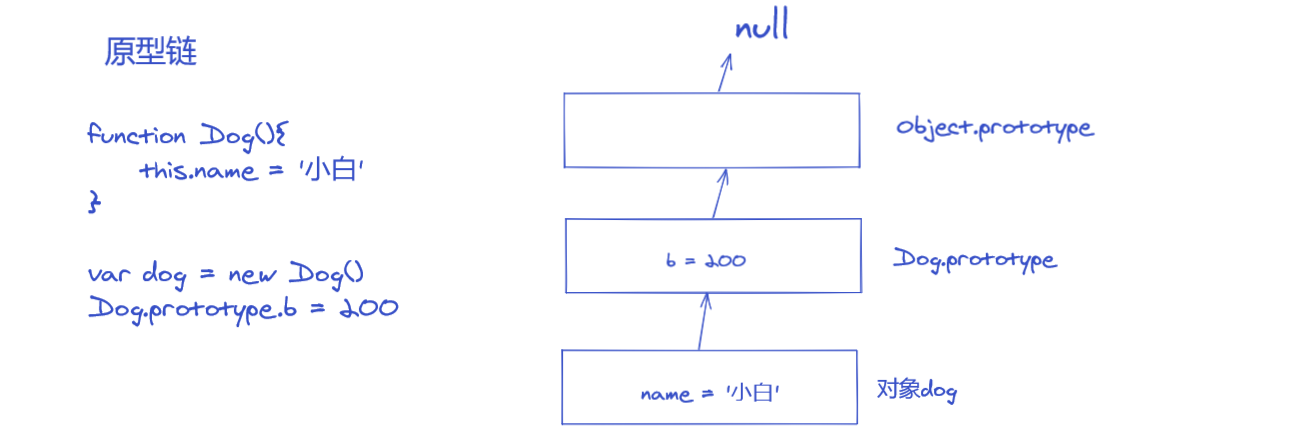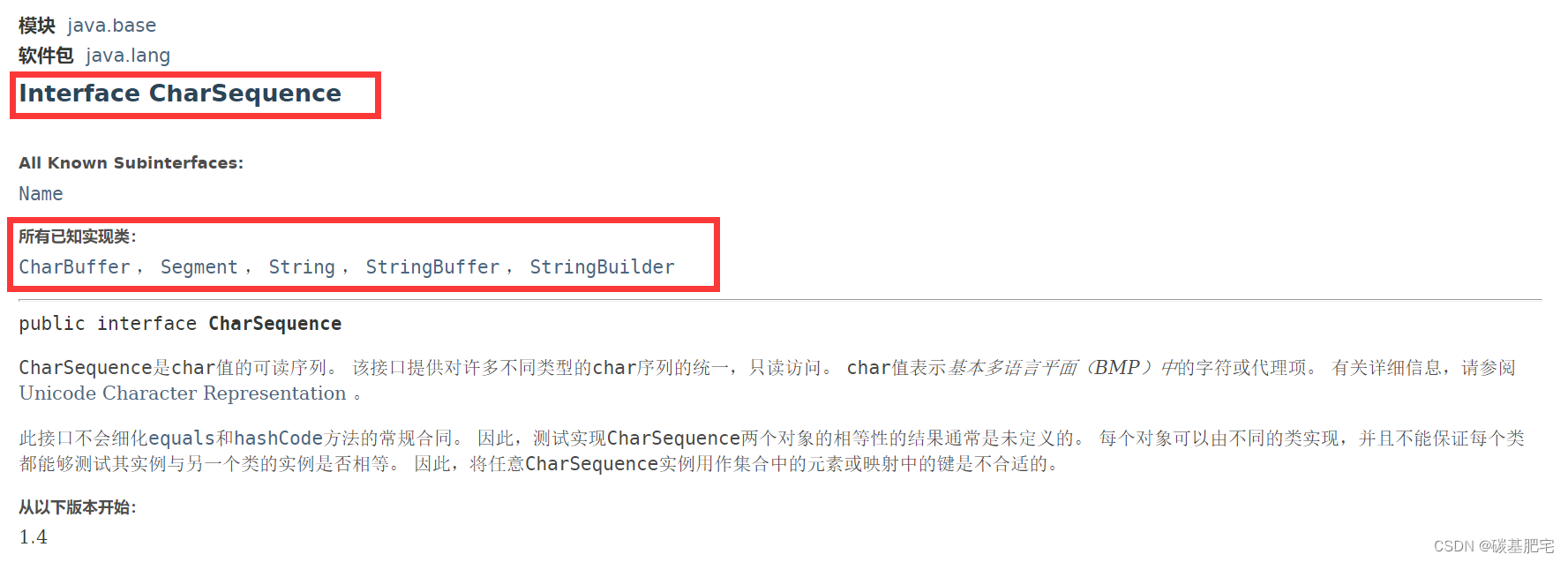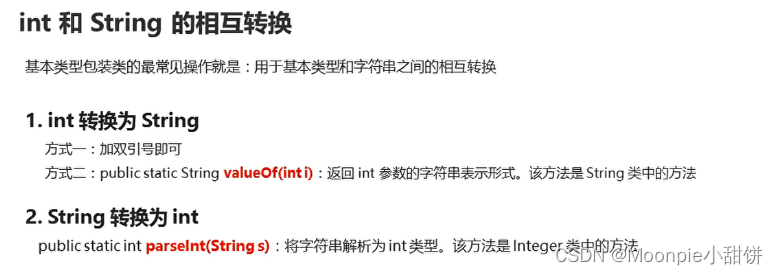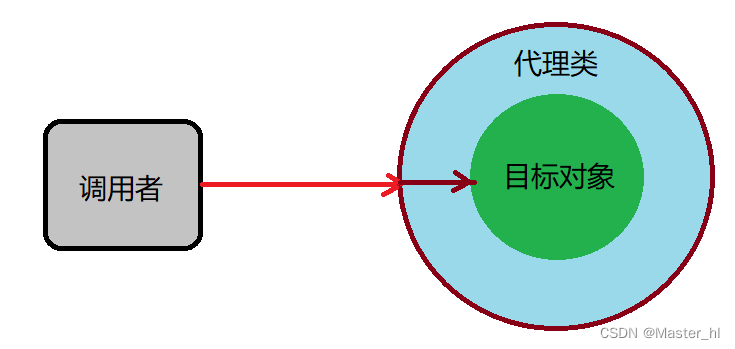文章目录
- 为什么需要智能指针?
- 智能指针的原理及使用
- 智能指针的原理
- 智能指针的使用
- C++中的智能指针
- C++智能指针的发展历程
- std::auto_ptr
- std::auto_ptr的使用
- std::auto_ptr的模拟实现
- std::unique_ptr
- std::unique_ptr的使用
- std::unique_ptr的模拟实现
- std::shared_ptr
- std::shared_ptr的使用
- std::shared_ptr的模拟实现
- std::shared_ptr的线程安全问题
- std::weak_ptr
- std::shared_ptr的循环引用
- std::weak_ptr的使用
- std::weak_ptr的模拟实现
- 智能指针的定制删除器
为什么需要智能指针?
下面我们分析一段关于异常安全的代码:
#include <iostream>
using namespace std;double division(int a, int b)
{// 当b == 0时抛出异常if (b == 0){throw "division by zero condition!";}return (double)a / (double)b;
}void func()
{// 这里可以看到如果发生除0错误抛出异常,另外下面的array没有得到释放。// 所以这里捕获异常后并不处理异常,异常还是交给外面处理,这里捕获了再// 重新抛出去。int* array = new int[10];int len, time;cin >> len >> time;try{cout << division(len, time) << endl;}catch (...) // 拦截异常,不是要处理异常,而是要正常释放资源{cout << "delete []" << array << endl;delete[] array;throw; // 捕获到什么对象就重新抛出什么对象}cout << "delete []" << array << endl;delete[] array;
}int main()
{try{func();}catch (const char* errmsg){cout << errmsg << endl;// 记录日志}return 0;
}
由于division函数可能会抛异常,所以如果直接在main函数捕捉异常,就会导致申请出来的array资源没有得到释放,就会导致内存泄漏问题。
怎么解决这个问题呢?
- 在Func函数中拦截异常,将array资源释放掉,再将异常重新抛出。
- 申请资源后将指针交给智能指针管理。
智能指针的原理及使用
上述的异常问题,可以通过智能指针来解决。
智能指针的原理
智能指针运用了RAII的思想。RAII(Resource Acquisition Is Initialization)是一种利用对象生命周期来控制程序资源(如内存、文件句柄、网络连接、互斥量等等)的简单技术。
在对象构造时获取资源,接着控制对资源的访问使之在对象的生命周期内始终保持有效,最后在对象析构的时候释放资源。借此,我们实际上把管理一份资源的责任托管给了一个对象。这种做法有两大好处:
- 不需要显式地释放资源。
- 采用这种方式,对象所需的资源在其生命期内始终保持有效。
智能指针的使用
设计一个智能指针SmartPtr:
- 在构造SmartPtr时,将用户传入的资源管理起来
- 在析构SmartPtr时,将管理的资源释放
- 智能指针SmartPtr能像指针一样进行解引用操作
template<class T>
class SmartPtr
{
public:SmartPtr(T* ptr):_ptr(ptr){}T& operator*(){return *_ptr;}T* operator->(){return _ptr;}~SmartPtr(){cout << "delete: " << _ptr << endl;delete _ptr;}private:T* _ptr;
};实验代码:
double division(int a, int b)
{// 当b == 0时抛出异常if (b == 0){throw "division by zero condition!";}return (double)a / (double)b;
}void func()
{int* ptr = new int;SmartPtr<int> sp(ptr); // 使用智能指针管理ptr资源int len, time;cin >> len >> time;cout << division(len, time) << endl;
}int main()
{try{func();}catch (const char* errmsg){cout << errmsg << endl;}return 0;
}
实验结果:

在func函数中,申请了ptr资源并交于SmartPtr进行管理,当出现除0错误,异常由division函数抛出,main函数捕捉时,func函数的函数栈帧销毁,SmartPtr对象也被回收,SmartPtr对象销毁之前会调用析构函数释放管理的资源,这样就避免了内存泄漏的问题。
但是这样的SmartPtr智能指针还有问题:
int main()
{SmartPtr<int> sp1(new int);SmartPtr<int> sp2(sp1);return 0;
}
运行结果:
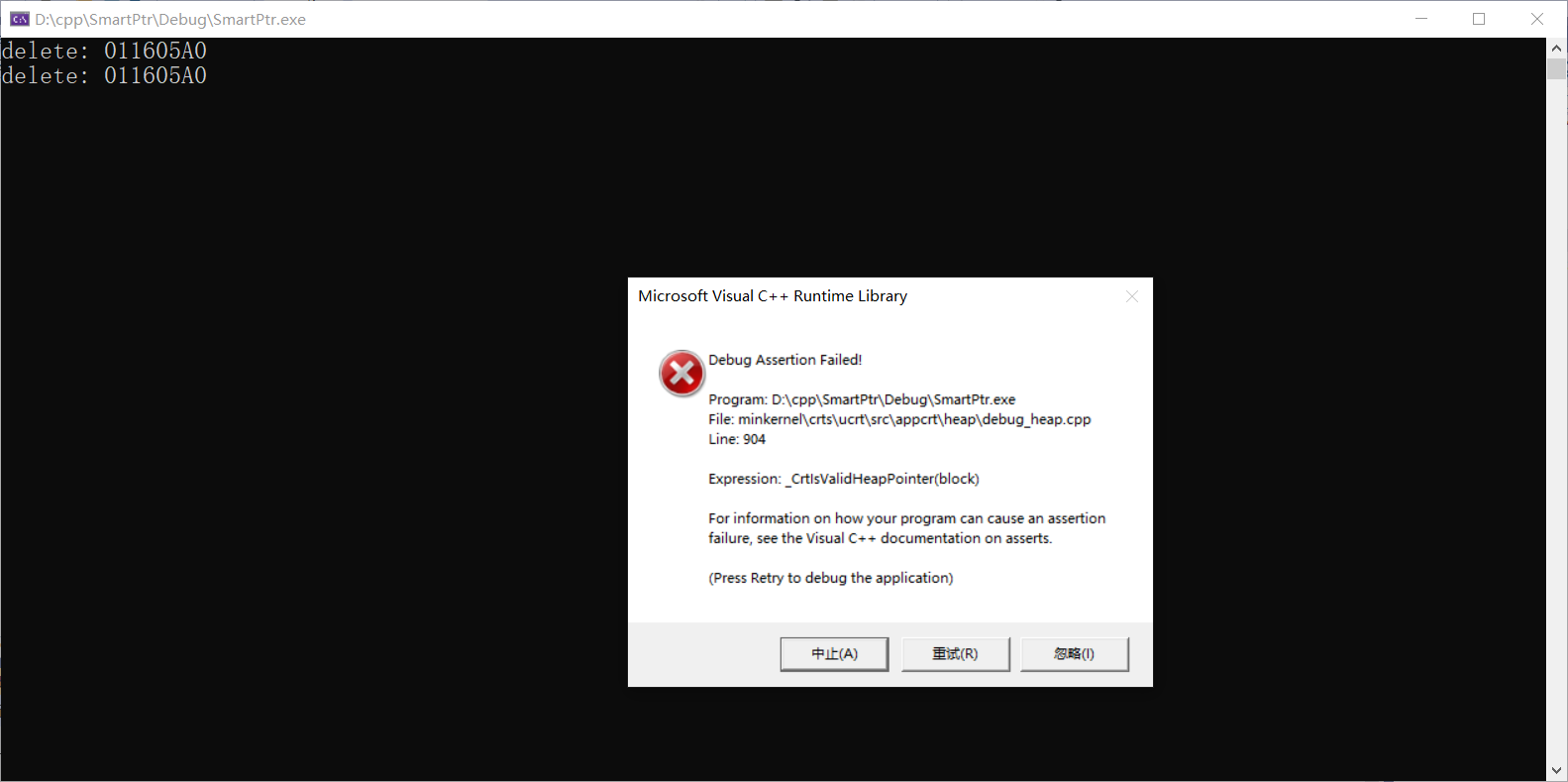
SmartPtr智能指针不能进行拷贝构造,因为这样会释放两次资源,导致程序崩溃。
C++中的智能指针
C++智能指针的发展历程
- C++98标准中产生了第一个智能指针
auto_ptr - C++ boost库中给出了更实用的scoped_ptr、shared_ptr和weak_ptr
- C++11标准中引入了unique_ptr、shared_ptr和weak_ptr,这些智能指针的实现原理都是参考boost库的,unique_ptr参考的是scoped_ptr
std::auto_ptr
std::auto_ptr的使用
C++ auto_ptr智能指针文档
std::auto_ptr的实现原理是管理权的转移。
实验代码:
#include <iostream>
#include <memory>int main()
{std::auto_ptr<int> ap1(new int(10));std::auto_ptr<int> ap2(ap1);return 0;
}
实验结果:
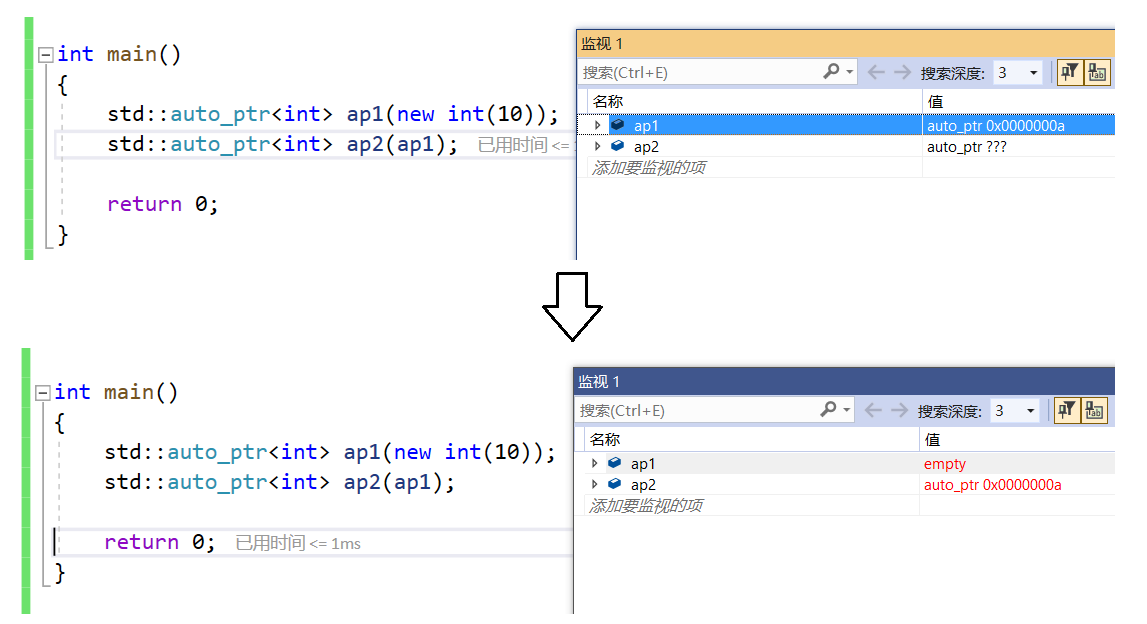
std::auto_ptr解决智能指针拷贝构造的问题是用管理权转移解决的,但是随之而来会带来另一个问题,管理权转移让ap1指针悬空了,如果用户对std::auto_ptr不熟悉,继续使用ap1进行一系列操作,而ap1已经悬空,这势必会导致程序的崩溃。
实验代码:
#include <iostream>
#include <memory>int main()
{std::auto_ptr<int> ap1(new int(10));std::auto_ptr<int> ap2(ap1);*ap1 = 20;return 0;
}
实验结果:

std::auto_ptr的模拟实现
下面简化模拟实现了一份auto_ptr来了解它的原理:
namespace cwx
{template<class T>class auto_ptr{public:auto_ptr(T* ptr = nullptr):_ptr(ptr){}auto_ptr(auto_ptr<T>& ap):_ptr(ap._ptr){// 管理权的转移ap._ptr = nullptr;}T& operator*(){return *_ptr;}T* operator->(){return _ptr;}private:T* _ptr;};
}
std::unique_ptr
std::unique_ptr的使用
std::auto_ptr管理权转移的方式,经过时间的证明,它是一个失败的设计。C++11中引入更加实用的std::unique_ptr和std::shared_ptr。
std::unique_ptr是参考了boost库中的scoped_ptr,它的原理非常简单粗暴,它解决智能指针拷贝构造的方式是直接防拷贝。
实验代码:
#include <iostream>
#include <memory>int main()
{std::unique_ptr<int> up1(new int);std::unique_ptr<int> up2(up1); // errorreturn 0;
}
实验结果:
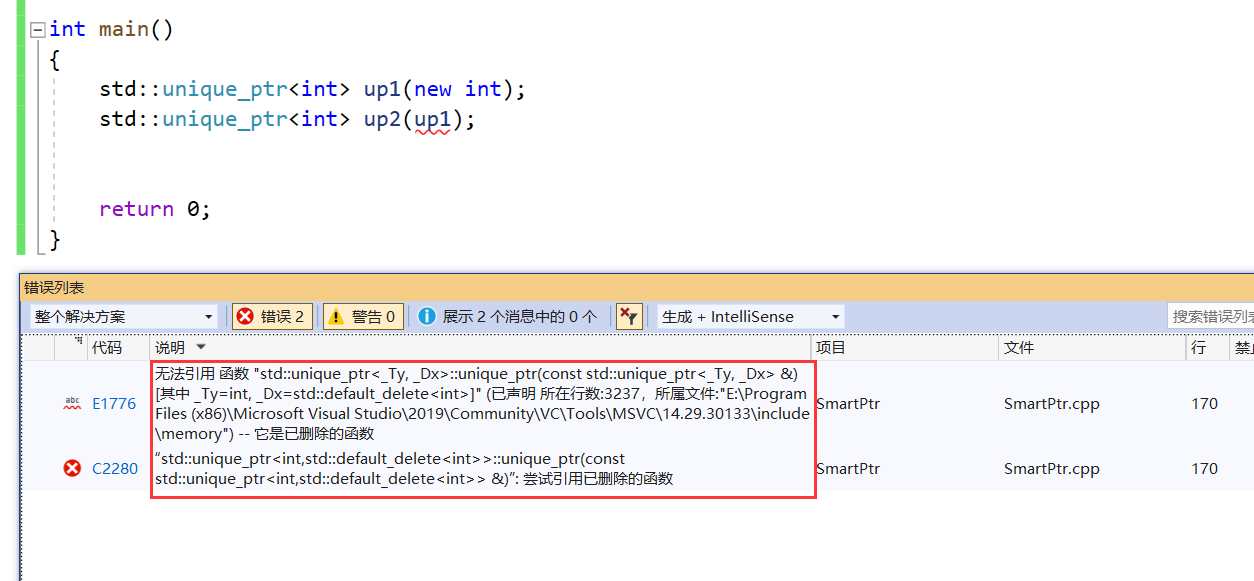
std::unique_ptr的模拟实现
下面简化模拟实现了一份unique_ptr来了解它的原理:
namespace cwx
{template<class T>class unique_ptr{public:unique_ptr(T* ptr = nullptr):_ptr(ptr){}// 防拷贝unique_ptr(const unique_ptr<T>&) = delete;unique_ptr<T>& operator=(const unique_ptr<T>&) = delete;T& operator*(){return *_ptr;}T* operator->(){return _ptr;}~unique_ptr(){if (_ptr){delete _ptr;}}private:T* _ptr;};
}
std::shared_ptr
std::shared_ptr的使用
std::unique_ptr实现了简单粗暴的防拷贝,但是难以避免要需要用到拷贝。C++11引入了std::unique_ptr,std::unique_ptr使用了引用计数的技术来实现智能指针的拷贝问题。
std::unique_ptr的原理:是通过引用计数的方式来实现多个std::unique_ptr对象之间共享资源。
std::unique_ptr在其内部,给每个资源都维护了着一份计数,用来记录该份资源被几个对象共享。- 在对象被销毁时(也就是析构函数调用),就说明当前对象不使用该资源了,对象的引用计数减一。
- 如果引用计数是0,就说明自己是最后一个使用该资源的对象,必须释放该资源。
- 如果引用计数不是0,就说明除了自己还有其他对象在使用该份资源,不能释放该资源,否则其他对象就成野指针了。
实验代码:
#include <iostream>
#include <memory>int main()
{std::shared_ptr<int> sp1(new int(10));std::shared_ptr<int> sp2(sp1);std::shared_ptr<int> sp3(new int(20));sp3 = sp2;return 0;
}
实验结果:
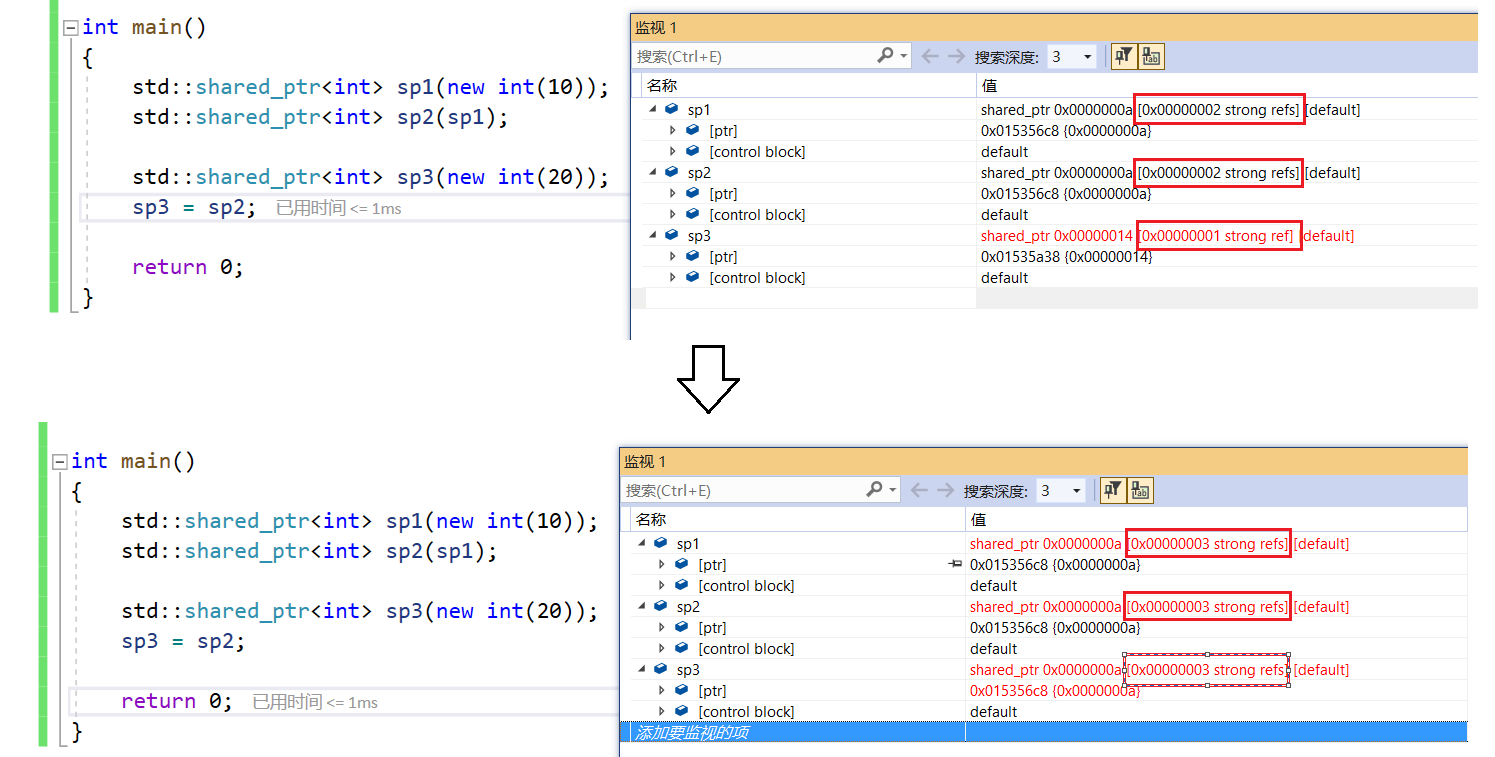
原理:
std::shared_ptr<int> sp1(new int(10));定义了智能指针sp1,管理new出来的int空间,sp1对象中的引用计数加一,refs = 1std::shared_ptr<int> sp2(sp1);定义了智能指针sp2,拷贝sp1,sp1和sp2对象中的引用计数加一,refs = 2std::shared_ptr<int> sp3(new int(20));定义了智能指针sp3,管理new出来的int空间,sp3对象中的引用计数加一,refs = 1sp3 = sp2;,sp3对象赋值拷贝sp2,原来sp3指向的空间的引用计数减一,refs = 0,则释放值为20的空间,sp3现在指向值为10的空间,sp1、sp2和sp3的引用计数加一,refs = 3

std::shared_ptr的模拟实现
namespace cwx
{template<class T>class shared_ptr{public:shared_ptr(T* ptr = nullptr):_ptr(ptr), _pRefCount(new int(1)){}shared_ptr(const shared_ptr<T>& sp):_ptr(sp._ptr), _pRefCount(sp._pRefCount){++(*_pRefCount);}shared_ptr<T>& operator=(const shared_ptr<T>& sp){if (_ptr != sp._ptr){if (--(*_pRefCount) == 0 && _ptr){delete _ptr;delete _pRefCount;}_ptr = sp._ptr;_pRefCount = sp._pRefCount;++(*_pRefCount);}return *this;}T& operator*(){return *_ptr;}T* operator->(){return _ptr;}~shared_ptr(){if (--(*_pRefCount) == 0 && _ptr){delete _ptr;delete _pRefCount;}}private:T* _ptr;int* _pRefCount;};
}
std::shared_ptr的线程安全问题
模拟实现的shared_ptr还存在线程安全的问题,由于管理同一个资源的多个对象的引用计数是共享的。
在多线程环境下可能会同时对同一个引用计数进行自增或自减操作,而自增和自减操作都不是原子操作,因此需要通过加锁来对引用计数进行保护,否
则就会导致线程安全问题。
加锁后代码:
- 将进行引用计数自增自减的代码封装成函数,便于加锁
- 引入mutex,对自增自减操作进行加锁
namespace cwx
{template<class T>class shared_ptr{public:shared_ptr(T* ptr = nullptr):_ptr(ptr), _pRefCount(new int(1)), _pmtx(new mutex){}shared_ptr(const shared_ptr<T>& sp):_ptr(sp._ptr), _pRefCount(sp._pRefCount), _pmtx(sp._pmtx){AddRef();}void AddRef(){_pmtx->lock();++(*_pRefCount);_pmtx->unlock();}shared_ptr<T>& operator=(const shared_ptr<T>& sp){if (_ptr != sp._ptr){Release();_ptr = sp._ptr;_pRefCount = sp._pRefCount;AddRef();}return *this;}void Release(){_pmtx->lock();bool flag = false;if (--(*_pRefCount) == 0 && _ptr){delete _ptr;delete _pRefCount;flag = true;}_pmtx->unlock();if (flag){delete _pmtx;}}T& operator*(){return *_ptr;}T* operator->(){return _ptr;}T* get() const{return _ptr;}~shared_ptr(){Release();}private:T* _ptr;int* _pRefCount;mutex* _pmtx;};
}
std::weak_ptr
std::shared_ptr的循环引用
实验代码:
struct ListNode
{int _val;cwx::shared_ptr<ListNode> _prev;cwx::shared_ptr<ListNode> _next;~ListNode() { cout << "~ListNode()" << endl; }
};int main()
{cwx::shared_ptr<ListNode> node1(new ListNode);cwx::shared_ptr<ListNode> node2(new ListNode);node1->_next = node2;node2->_prev = node1;return 0;
}
实验结果:
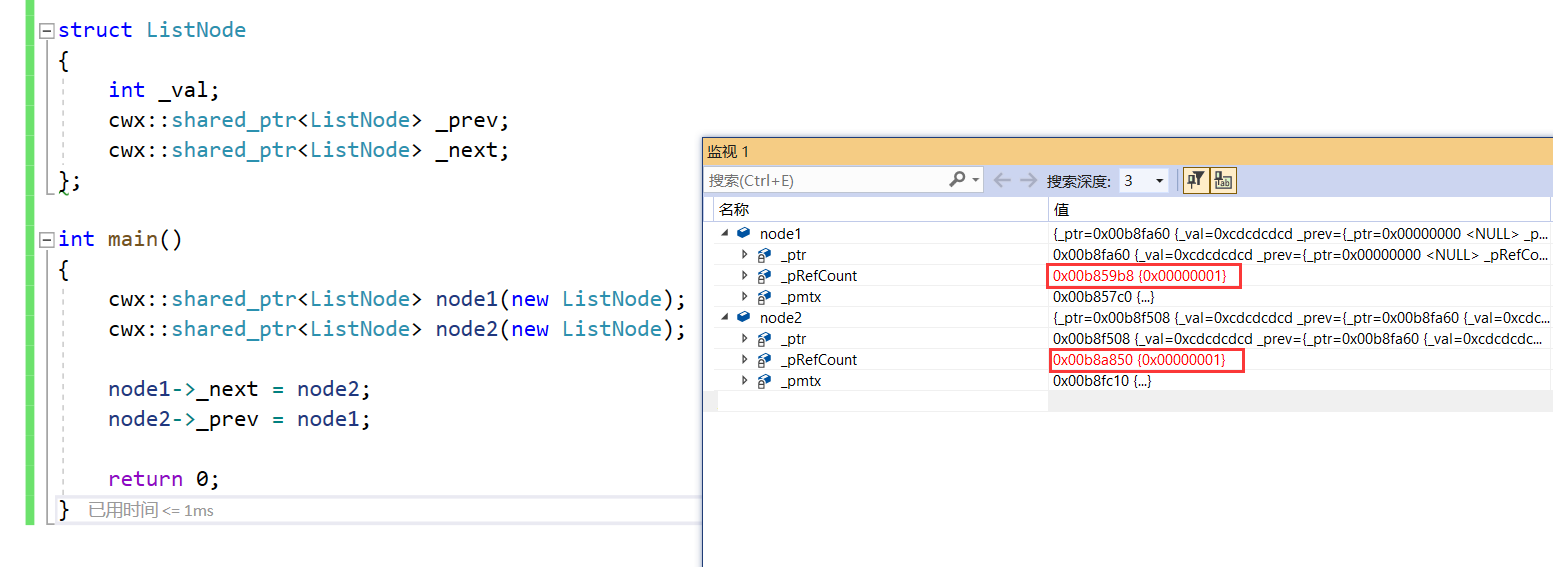
实验原理
程序创建了node1和node2两个链表结点,用shared_ptr智能指针管理,node1和node2的引用计数当前分别为1,node1的_next指向node2,node2的_prev指向node1,此时node1和node2的引用计数分别为2。
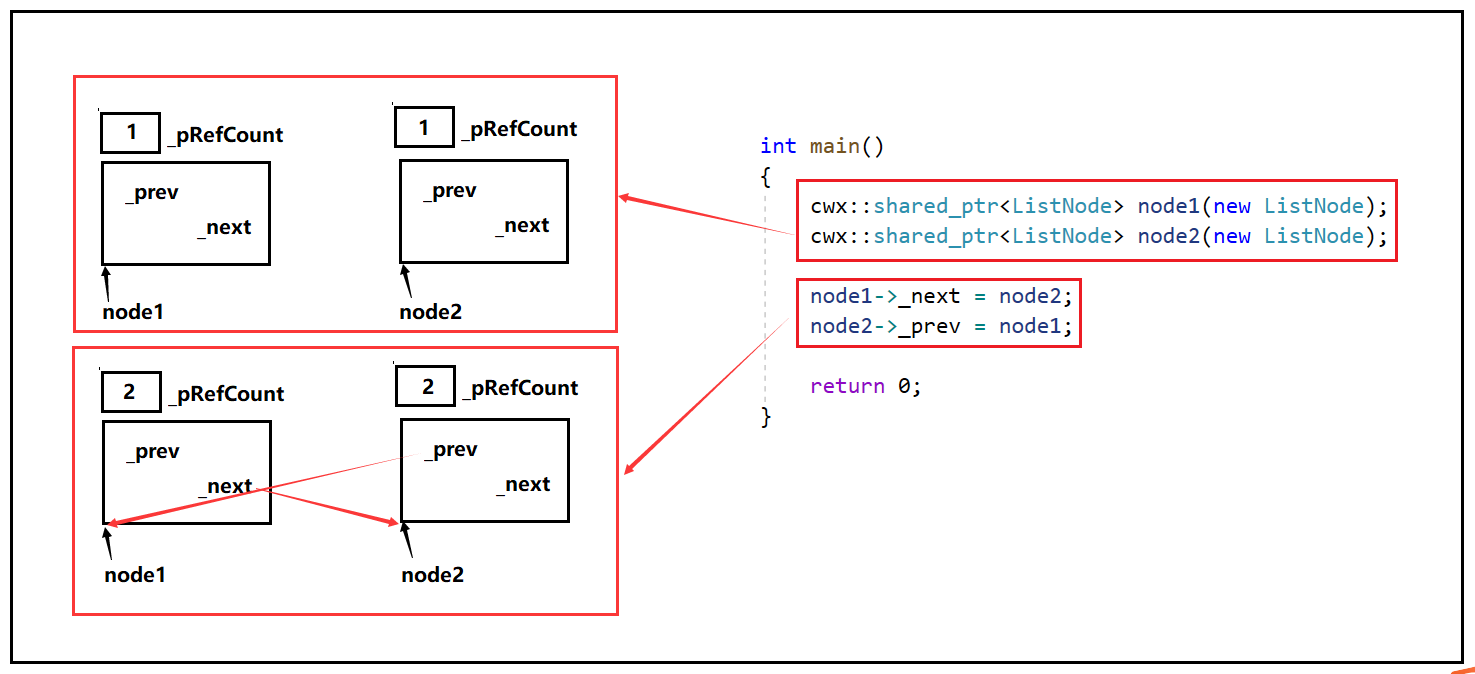
程序运行结束后,node1和node2调用析构函数,引用计数减一,此时引用计数为1,然而程序已经结束,node1和node2开辟的空间并没有被释放,这种现象叫做循环引用。
std::weak_ptr的使用
在上述的实验场景中,循环引用导致资源没有被释放的问题,需要使用std::weak_ptr来解决。
std::weak_ptr的原理是可以获取并访问指向的资源,但是不参与引用计数。
实验代码:
struct ListNode
{int _val;weak_ptr<ListNode> _prev;weak_ptr<ListNode> _next;~ListNode() { cout << "~ListNode()" << endl; }
};int main()
{shared_ptr<ListNode> node1(new ListNode);shared_ptr<ListNode> node2(new ListNode);node1->_next = node2;node2->_prev = node1;return 0;
}
实验结果:
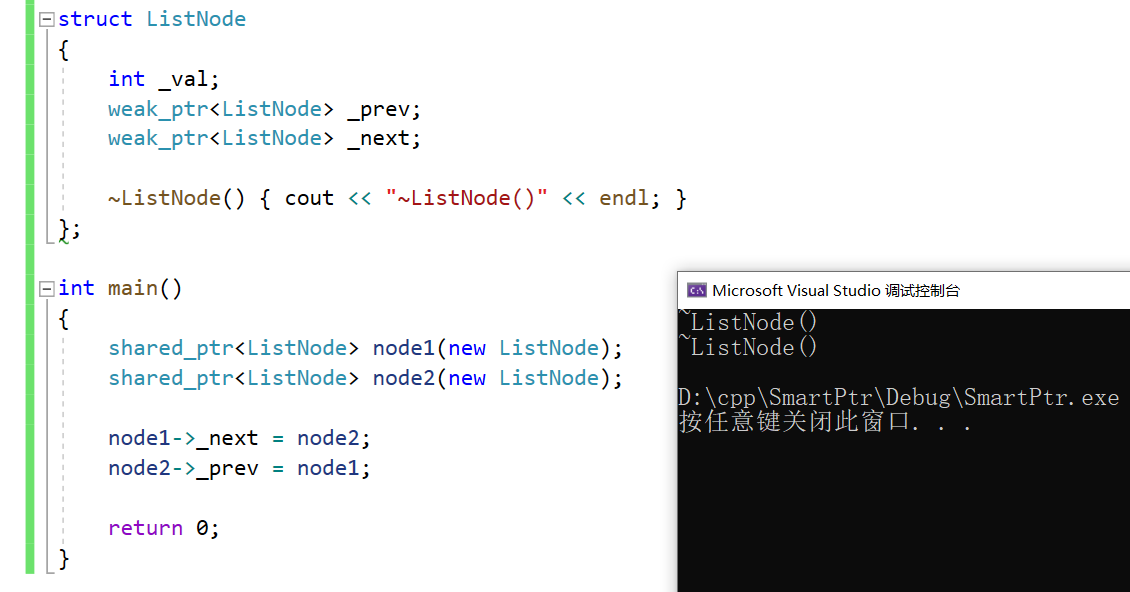
std::weak_ptr的模拟实现
下面简化模拟实现了一份weak_ptr来了解它的原理:
namespace cwx
{template<class T>class weak_ptr{public:weak_ptr():_ptr(nullptr){}weak_ptr(const shared_ptr<T>& sp):_ptr(sp.get()){}weak_ptr<T>& operator=(const shared_ptr<T>& sp){_ptr = sp.get();return *this;}T& operator*(){return *_ptr;}T* operator->(){return _ptr;}private:T* ptr;};
}
智能指针的定制删除器
模拟实现的智能指针默认都用delete释放资源,但是如果是申请一个数组资源,fopen打开一个文件,delete就会不匹配或者程序直接就崩溃了。
C++文档中,智能指针的接口定义了一个模板D,就是定制删除器。定制删除器本质是一个可调用对象,比如函数指针、仿函数或者lambda表达式。

下面给unique_ptr实现一个简化的定制删除器:
namespace cwx
{template<class T, class D = default_delete<T>>class unique_ptr{public:unique_ptr(T* ptr = nullptr):_ptr(ptr){}// 防拷贝unique_ptr(const unique_ptr<T>&) = delete;unique_ptr<T>& operator=(const unique_ptr<T>&) = delete;T& operator*(){return *_ptr;}T* operator->(){return _ptr;}~unique_ptr(){if (_ptr){D del;del(_ptr);}}private:T* _ptr;};
}template<class T>
struct DelArray
{void operator()(const T* ptr){delete[] ptr;}
};template<class T>
struct DelFile
{void operator()(FILE* file_name){cout << "fclose: " << file_name << endl;fclose(file_name);}
};int main()
{unique_ptr<int, DelArray<int>> up1(new int[10]);unique_ptr<FILE, DelFile<FILE>> up2(fopen("test.txt", "w"));return 0;
}

